SONY released its new flagship TV XBR-A1E Bravia 4K OLED TV at the Consumer Electronics Show (CES) earlier this year. A1E has attracted countless eyeballs as soon as it is open, and digital media have lauded: "Sony finally returned to OLED!"

She is very thin and she is cool. Her display effect is stunning. The key is that she uses the next generation of display technology: OLED.
Although LED and OLED are only one letter, they are two very different technologies. Television display technology has been popular in human history, but there are two types: CRT tubes and LCD liquid crystals. Most people today still use LCD technology for their computers, flat-screen TVs, and mobile phone displays. The so-called "LED" refers to the backlight of the liquid crystal, which uses the LED light-emitting technology and still belongs to the liquid crystal type.
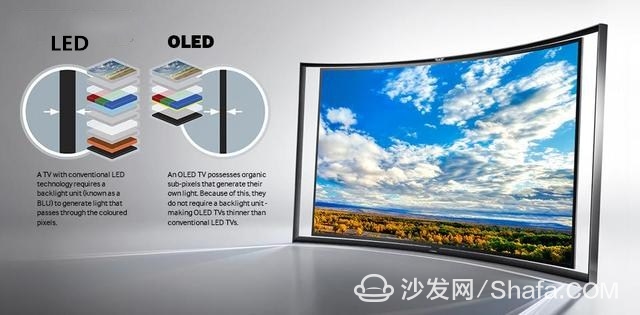
The third-generation display technology behind the liquid crystal has fallen into competition, such as DLP laser projection TVs, plasma TVs, and OLED (organic light-emitting diode) television. Unlike liquid crystals, each pixel of an OLED self-illuminates and does not require a light source such as an LED as its backlight. OLED also has many advantages:
"Black is black." Because of the display principle, when the display is black, the pixels do not emit light at all and the theoretical contrast is infinite; the color is more accurate and the color gamut is wider; it can be very thin. SONY A1E is only 7.8mm thick; LG's “Wallpaper TV†W series is only 2.57mm; “science fiction†displays such as flexible screens and translucent screens can be realized.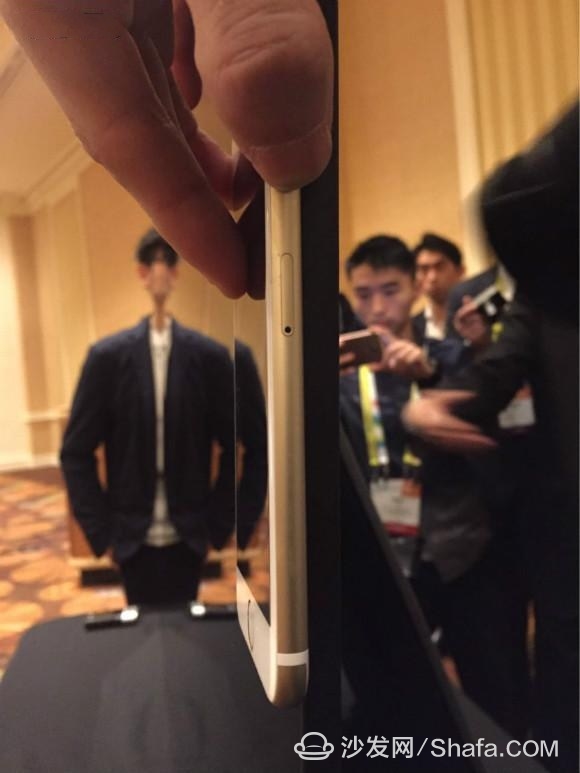
Although there are many advantages, OLEDs have become more popular. The most common OLED screens for everyone are Samsung's Galaxy series phones. It is rumored that the next generation of iPhones will also use OLEDs. Sony has attempted to launch 11-inch OLED TVs, which have met with poor market conditions. Since then, it has only been used in color monitors for professional broadcasters, and the home market is still committed to exploiting the potential of LCDs. At CES 2014, the four major TV makers Samsung, LG, Sony, and Matsushita collectively released their respective OLED TV prototypes and disappeared afterwards, leaving only LG to insist silently every year. Until this year, Sony finally used A1E, a flagship product with a unique design and high quality, to make it clear: The next-generation TV display technology is none other than OLED.
In addition to being thin, Sony A1E has the following features:
Adopt LG's OLED panel to achieve 4K UHD resolution, support HDR10, completely cover the DCI-P3 color gamut. The X1 Extreme image processor upgraded from the LCD flagship Z9D can make 4K HDR images more pure, reduce afterimages, and provide a wider viewing angle. This is a key technology for improving the picture quality. With Acoustic Surface technology, the screen can be directly sounded, enabling the design of an extremely narrow frame with no audio bar. Android TV 6.0 system can be controlled by Google Home.We tested the 65-inch model, and it was already too large for one person to control. Two or three talents must be lifted. First look at the design -
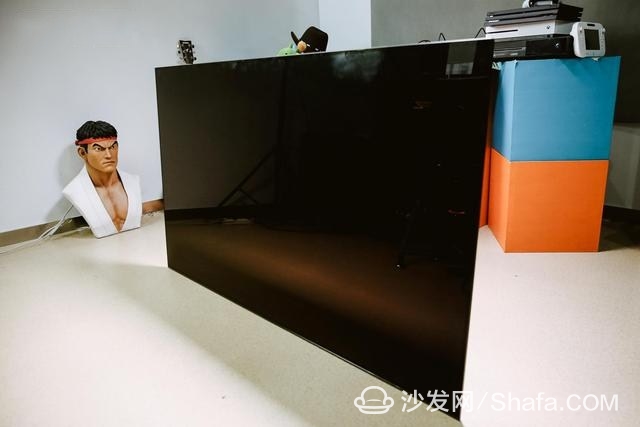
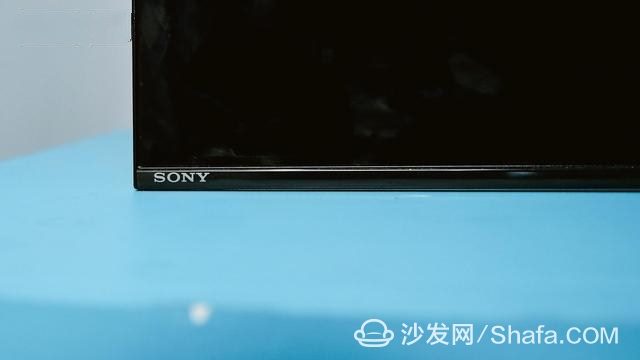
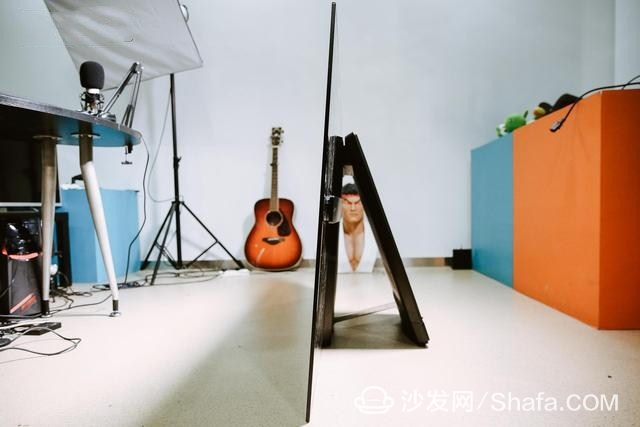
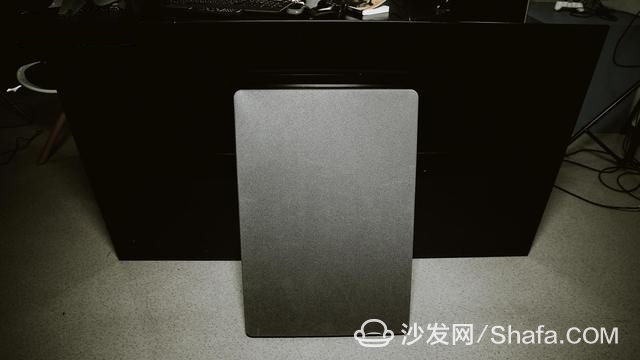
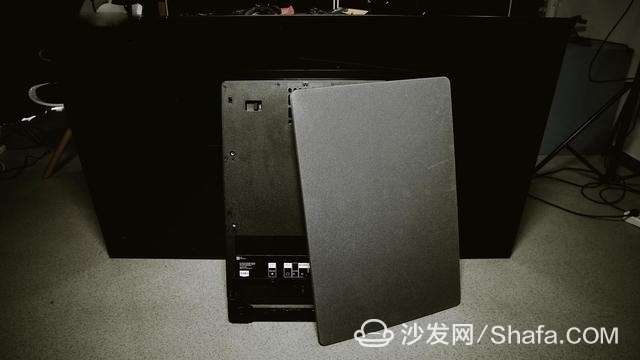
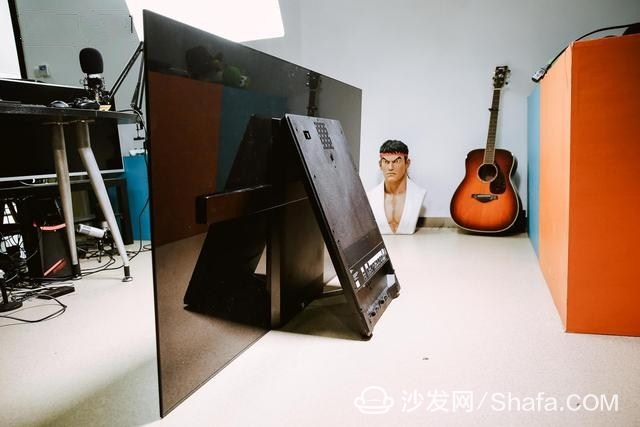
After connecting to the PS4 Pro, you need to make a series of settings to see the effect of the "true 4K HDR." This time you have to patiently understand the relevant standards. The old training of "one price, one price" is certainly justified. But to understand more about what "dry goods" the "per cent price" has changed to, is the biggest joy for me as a digital enthusiast. For television, it is to look at parameters and see standards.
The next part may be boring. But believe me, once you understand it, you will no longer be afraid to be beaten by the hype of the shop's misplaced hype!

The 4K standard may be much more than you think... In fact, there are 4K standards for everything from shooting, broadcasting, coding and playing. The 4K that we generally talk about is actually the 4K Ultra HD proposed by the Consumer Electronics Association (CEA), which has a resolution of 3840×2160 pixels (2160P), four times the resolution of 1080p, and 8.3 million pixels on the same screen. There are many display devices with physical resolutions that can meet this standard, especially PC monitors, but do not naively think that it can be compared to TV.
Orange is 4K resolution2. Color format
Find "Resolution" through PS4 Pro's "System Settings" → "Audio and Display" → "Image Output Settings". After setting the resolution to 2160P, select the color format. RGB and YUV420 are two popular color coding formats. RGB is a lossless format that works best but takes up more bandwidth; the latter is lossy compression, which is not as effective as RGB but saves bandwidth. Here we set the RGB Range to "Auto", which will usually use the RGB format. When the PS4 Pro outputs HDR content, it will automatically switch to the higher compression YUV420. The reason for this setup is mainly due to insufficient HDMI 2.0 bandwidth, as discussed below.
3.HDR and wide color gamutHDR refers to "high dynamic range." In simple terms, the screen is "black and black, brighter and brighter." The relative video content that currently does not have HDR effects is called SDR (General Dynamic Range). This term and 4K have become the most popular words in the current high-end television, but there are also great misunderstandings. I noticed that some of the low-end 4K LCD TVs in China that cost around RMB 3, 4000 are also known as “HDR†in the promotion. In fact, these “wild HDRs†simply do not meet the industry standards, and they are at best only a kind of picture. Post processing.
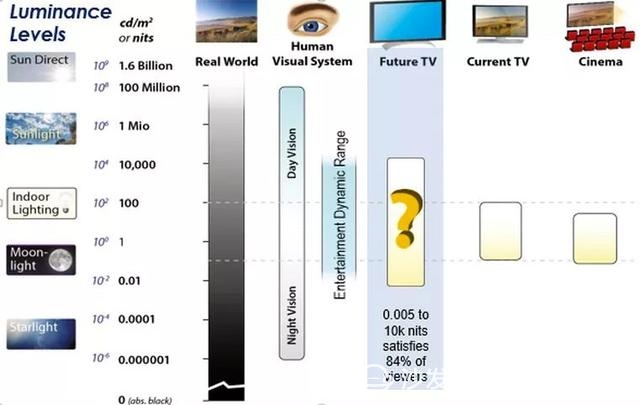
(Photo from Dolby Laboratories)
Let's talk about the principle of HDR. The unit of measurement of direct sunlight is cd/m2, also known as nit. The darkness of the darkness, namely 0 nits, the starlight of 0.001 nits, the moonlight of 0.01 to 1 nit, the ordinary indoor lighting of 100 nits, the mobile phone screen of 300-500 nits, and the bright daytime 10,000 – 1 million nits. The perceptible brightness range of the human eye is relatively wide. The traditional standard brightness range (SDR) can display a brightness range of 0.01 to 100 nits, and the traditional 1080P Blu-ray disc has a maximum brightness of only 100 nits. The new generation of 4K HDR TVs can display a wider range of brightness, thereby significantly increasing the contrast.

The figure above is a comparison of the displayable range of SDR and HDR. HDR must cover everything from shooting, post-production, color-grading, distribution, and display restoration to ensuring the ultimate "true HDR" effect.
In the implementation of HDR effects, the characteristics of LCD TVs and OLED TVs are also different. As mentioned above, the display principle of OLED is that the black level is deeper, so the details in the dark part are more excellent, and it is easy to cover a wider contrast; and because of the natural defects of the liquid crystal, the black level is difficult to press down (Samsung’s Quantum Dots and the Sony Z9D's "local light control" technology all provide finer control of the backlight. Only the peak brightness can be increased to increase the contrast.

From the above figure, we can see that OLEDs are the best at performing the "midnight sky." Even though the night is dark, the stars are still shining, and even the mountains and rivers under the moonlight can be seen; and the liquid crystal is subject to Backlit, dark details are more lost. In the high-exposure part, the liquid crystal also easily loses the details of the highlights. A typical scene is the explosion in Hollywood blockbusters. The badly-exploded ball of light will see a block of white bright spots on the SDR/LCD screen; the OLED has the highest brightness. Although only 300-400 nits, it can show more highlight details. It can be said that the greatest advantage of OLED over LCD is reflected in the more natural and realistic effects of HDR.
A common misunderstanding here is to clarify: "The higher the brightness, the better the HDR effect." This is true on LCD TVs, but it does not apply to OLED screens with completely different technologies. We use the parameters mentioned in the Ultra HD Premium certification as an example:
Brightness over 1000 nits/black level below 0.05 nits (mainly for LCD displays) Brightness above 540 nits/black levels below 0.0005 nits (mainly for OLED displays)As long as the display device's peak brightness and black level reach one of these, HDR requirements can be met. As you can see, the advantage of OLED is that the black level is much lower than the LCD, not the peak brightness. Unfortunately, in the existing reproduction methods such as “screen captureâ€, it is difficult for users to realize the “darker but more beautiful†visual perception of OLEDs.

Unfortunately, although the resolution has been determined, the HDR standard that accompanies the 4K is still in the format war. The two most current mainstream standards are: HDR10 and Dolby Vision (Dolby Vision).
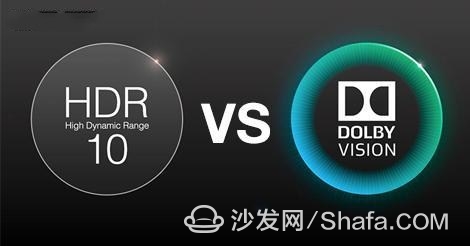
HDR10 is a free standard that currently covers the widest range. Both the PS4 Pro and Xbox One S are the two major HD game consoles and the vast majority of 4K Blu-ray discs. The Sony A1E also supports this standard. Dolby Vision's introduction of Dolby Vision is more advanced and advanced, not to mention 4K, and it is more than enough for 8K after 2020. Due to the need for built-in dedicated chips, there are few devices currently supported.
Since color also has brightness/grayscale properties, HDR will inevitably bring about an increase in color expression. This is why the contrast between 1080P Full HD and 4K HDR versions of many films not only enhances the resolution and contrast, but also makes the tone look different.

Color expression can be quantified in two dimensions: color depth (up to how many colors can be displayed) and color gamut (which color ranges are covered).

Different HDR standards correspond to different color ranges. The larger the triangle, the richer the color. From the above figure we can see:
The Rec. 709 color gamut corresponding to 1080P full HD is the so-called "sRGB" color gamut. This color gamut is used by most Internet pictures, digital cameras, computers, and mobile phones; the HDR10 standard is a 10 bit color depth, which corresponds to a DCI-P3 or higher color gamut, 26% larger than sRGB, and contains 1.07 billion colors. The most common digital device covering the DCI-P3 color gamut at 100% is the Apple iPhone 7/7+ and iPad Pro. Dolby Vision uses the latest Rec. 2020 wide color gamut standard. This color gamut is 70% larger than sRGB. There is a 12-bit color depth corresponding to 8K. There is currently no civilian TV/display/laser projector on the planet that can completely cover this color gamut.As for some monitors and TVs, they are still propagating how many "NTSC color gamuts" they cover. I can only say "no stupid or bad." The NTSC color gamut is a standard proposed in 1953 and there is little content and equipment that really supports it. Some mobile phone and display manufacturers in China have raised this standard when they advertised, and they are deliberately misled. Just remember sRGB, Adobe RGB, DCI-P3, and Rec.2020.
But how much color we actually can see on TV depends on the appearance of HDMI and color format.
After reading the above explanation of HDR and gamut space, we can understand why after setting PS4 Pro's HDR to “automaticâ€, the “deep color output†item will also lock the association to “automaticâ€. The PS4 Pro automatically adjusts the output HDR effect and color mode according to your display device. The final result is shown below.
What does the last HDCP 2.2 mean here? Don't worry, read on.
4.HDMI and HDCPDo not underestimate the HDMI cable, it also affects the quality of the "true 4K HDR".
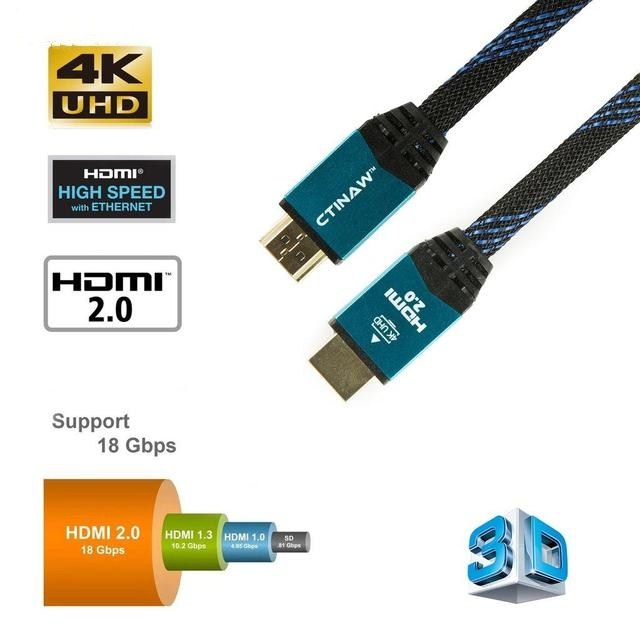
Like the familiar USB interface, HDMI is not only the name of a "salted dish" (wire), but also an interface and transmission standard. The advantage of HDMI is that an interface can transmit pure digital, lossless video and audio signals at the same time. It is currently the most widely used high-definition video and audio interface.
HDMI has gone through several versions. The latest version is 2.1 proposed this year, supporting a series of advanced features such as 8K resolution, and no actual equipment is currently used. Including the Sony A1E we are experiencing today, currently (in mid-2017) the commercially available 4K HDR TVs mainly use the HDMI 2.0 interface.

Please note that although HDMI 1.4 can support 4K resolution, the interface did not support 4K@50/60 Hz until HDMI 2.0 was proposed in 2013. "60 Hz" means that the screen refreshes 60 times per second - if you are looking for 60 frames per second game, then it should correspond to a refresh rate above 60 Hz. Many domestic low-end 4K TVs, the HDMI interface is still a 1.4 version a few years ago and can only reach 4K@30/24Hz (this is also the reason they are cheaper).
In addition, HDMI 2.0 has also increased the transmission bandwidth to 18 Gbps. HDMI 2.0a began to support HDR10 and Dolby Vision; HDMI 2.0b began to support another HDR standard HLG. Using the YUV420 with a high compression ratio in the color format, the HDR signal can be sent out in the bandwidth to keep the picture at 4K@50/60Hz. The above function HDMI 1.4 interface can not be done. Therefore, when selecting a game display device, be sure to confirm that the device's interface is HDMI 2.0.
CEC refers to a single remote controller that can control multiple AV devices connected by this HDMI cable. Sony's TV remote control can control its own PlayStation (Bravia Link) via the CEC channel.
Let me talk about "What line should I use?" The HDMI cable does not strictly correspond to the interface version, which is the same old line that you used a few years ago. It is also available on the new interface. As mentioned earlier, HDMI 2.0 will increase the transmission bandwidth to 18 Gbps to carry 4K @ 60Hz and HDR signals. Therefore, to ensure that the stable transmission of signals will not be insufficient bandwidth, we recommend that you use the PS4 Pro and Xbox One S bundled with HDMI. line.
If you must purchase it separately, it is best to choose a regular channel and purchase an HDMI cable that has "High Speed" or "Premium High Speed" certification. If you've ever had a fever headset, you know that the "sauerkraut" market is full of depth and cohabitation. According to my personal experience, 50-100 yuan can buy qualified wire.
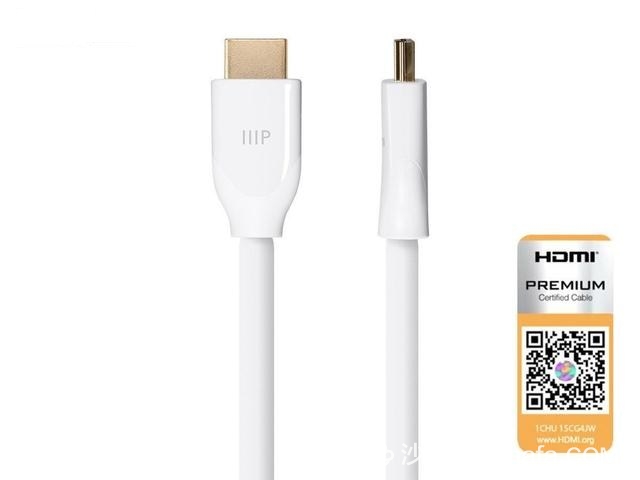
One of the four HDMI 2.0 input ports of the Sony A1E supports ARC (Audio Return), which is the audio signal sent back to the connected amplifier processing through this port. This is for super clear digital amplifiers. It is worth noting that of the four interfaces, only interfaces 2 and 3 support 4K@60Hz, and the other two only support 4K @ 24/30 Hz. Play games to choose 60Hz interface, 24Hz interface to keep watching movies just fine.
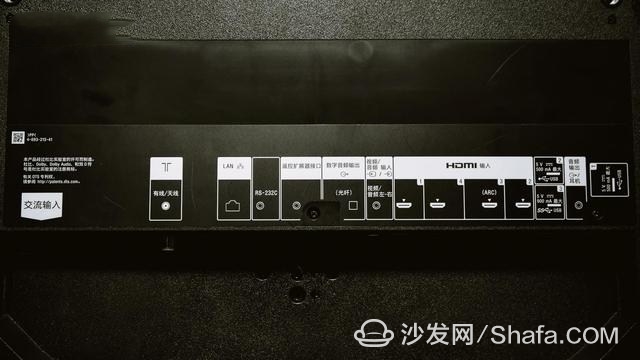
HDCP (High-Definition Digital Content Protection) is a copyright protection mechanism invented by Intel. The purpose is to prevent high-definition video content from being pirated when it is transmitted via the HDMI or DVI interface. The latest version is HDCP 2.2. This fee collection mechanism has become the de facto high-definition content encryption standard. Blu-ray discs, genuine online streaming media, and even high-definition satellite television in Europe and the United States use HDCP encryption. BD-rip movie resources you know.) Many PC users may not even be able to play even if they buy Blu-ray drives and genuine Blu-ray discs - because both your graphics card and your monitor must support HDCP. However, the game content is not affected by HDCP.
The above PS4 Pro screenshot shows HDCP 2.2 meaning the connected TV can play genuine HD content. PS4, PS4 Pro, and Xbox One all support HDCP, so it's good to open it in normal circumstances. If your display device does not support HDCP, you cannot play genuine Blu-ray discs and only play 4K games.
Another question is whether the Sony A1E can display in 120Hz mode. We have seen 120Hz on the TV's official website product parameters, but there is no such option in the actual display mode. There are a variety of "overclocking modes" in high-end TV products of major brands on the market, claiming to achieve a refresh rate of 240Hz or more. In this regard, authoritative evaluation agencies have done tests. In fact, the vast majority of products can only reach 120Hz. What's more, there is almost nothing that is output at a frame rate of 120fps or more. Therefore, there is a totally different concern about the problem of "60Hz is not enough."
5. SummaryMost of the 4K HDR Blu-ray discs have such a warm prompt behind:
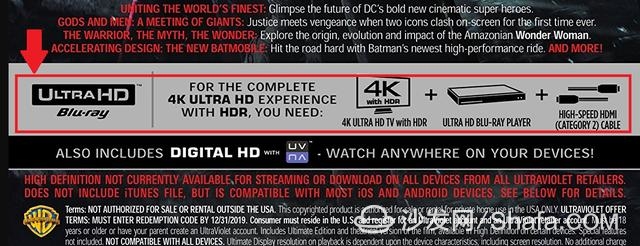
This graphic tells you that if you want to experience the full "real 4K HDR" you need: A TV supporting 4K HDR + a UHD Blu-ray player (game console) + a high-speed HDMI cable.
In practice, if you want to enjoy an uncompromising "true 4K HDR" game, the above rough device description is not enough. You have to ensure that the whole set of equipment meets the following standards:
HD game console device: PS4 Pro / Xbox One X Display device: HDMI 2.0 interface, support for 4K 2160P resolution, support for HDR10 or Dolby Vision cable: high-speed HDMI cable (supplied) Audio equipment: support for Dolby AtomsConnect the game console to the TV and confirm that it is displayed in the following modes:
4K+HDR game: 4K 2160P@60Hz, HDR (10bit DCI-P3 color space), color format YUV420 4K games: 4K 2160P@60Hz, no HDR (8bit sRGB color space), color format RGB playback 4K UHD Blu-ray Disc: Turn on HDCP 2.2If you have a low budget and you want to experience the "Kai Edition" 4K game, you should at least reach:
Display device: HDMI 1.4 interface 4K 2160P@60Hz without HDR (sRGB), YUV420Remember, you're not just picking TVs, you're picking a 4K+HDR quality solution that meets international standards.
Game experience: The HDR effect of the game depends mainly on technical power and conscienceLet's use the PS4 Pro to test several games to see how these games perform differently on the Sony A1E before and after the HDR is turned on. The Sony A1E has a built-in image mode. It is recommended to switch to "game" or "custom" to reduce input delay.
Please note: The screenshots and screen shots in the following games are all sRGB JPG images and do not contain HDR information. Coupled with the objective factors such as photography (screen device: Fujifilm X-T20/Canon 5D MKIII), picture compression, reader display device differences, etc., can not fully represent the actual HDR picture quality that the naked eye actually sees. for reference only.
I have created a 5-minute mini video for this article. There are dynamic clips.

Most games optimized for the PS4 Pro provide HDR effect switches in the picture options. Take the picture of Horizon Zero Dawn as an example:
The HDR effects of screenshots in these two games are all turned on, and the difference in screen output can already be seen. The following is still a screenshot of two games, please observe the difference between the two stars and characters:
The intuitive feeling of the naked eye is whether the details of the moon and the stars have increased after the HDR was turned on. But is the overall picture even more "dark"? This is because the color gamut of this picture is compressed to sRGB, and the original picture is richer in color on HDR-enabled displays and can reveal more details in the shadows. Unfortunately, whether it is a screenshot or a screen shot, it cannot be completely completed. Reproduce the charm of HDR.
Let's look at the screen shot renderings:


Pay attention to the observation: 1. The red plant in the lower left corner of the screen, after the HDR is turned on, the color is more plentiful and deeper than the white flower. 2. The body of the heroine has a stronger contrast between the light and the dark, and the screen shot reproduction does not reflect the details of the shadows. Actual visual observations are visible. 3. Castles in the distance are clearly visible after HDR is turned on, and the outlines are blurred when closed, as if they were to be swallowed by the background white.
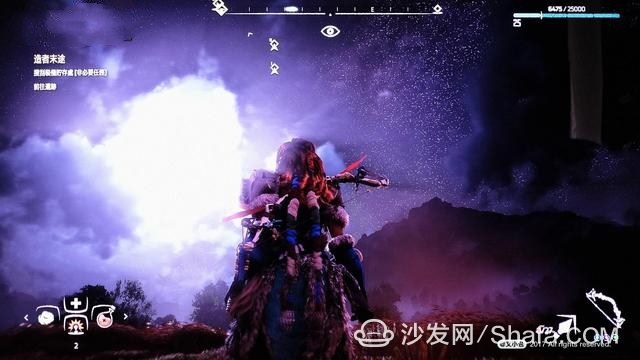
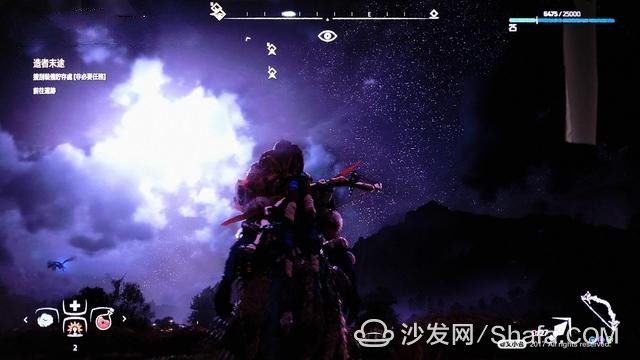
Observe: 1. The moon is covered by the cloud, and when the HDR is turned off, it turns into a large dragonfly. After the opening, the contrast of the clouds details are visible. 2. As a result of the overall lighting, the figures and distant mountains on the map appear to be illuminated by the searchlights. The figure below returns to darkness, but it is impossible to see clearly in the diagram. Actually, there are details in the naked eye.
"The Last of Us Remastered"

Note: When the HDR is off, the sun is ambiguous, as if it were a white mist; after opening, the sun's outline is clearly displayed, and the details of the surrounding clouds and blue sky are also more abundant.
"Uncharted 4: A Thief's End" (Uncharted 4: A Thief's End)

Observe the observations: 1. Comparison and details of sky clouds. 2. Assault boat splint wood color. 3. Details of the dark part of the black reef on the right side of the screen.


Pay attention to the observation: 1. The actor's face highlights, the heroine's arm highlights, overexposed when HDR is turned off, loses the skin material details; after opening, the light shadows are structured and details are fully visible. 2. The actor's dark hair is dark. After the HDR is turned on, the details are preserved. When it is closed, it is dark. 3. The overall tone, especially the color of the character, the background green plants. When the HDR is turned off, the cartoon “Sweet Water Sense†is more realistic and natural. (You can combine the above video experience)
Game summaryIn addition to the above games, we also tried games such as Battlefield 1, Final Fantasy 15, Mass Effect: Andromeda, Notorious Daybreak, and Call of Duty: Infinite War. However, it was found that these works either belonged to a long release date, had little effect on patch upgrades ("notorious: breaking the dawn"), or were barely visible before or after HDR was turned on ("Final Fantasy 15"), or there was no HDR switch. No comparison ("Quality Effect Andromeda"). Therefore, it is not difficult to find out whether the developer's optimization has taken root and whether there is sound technical force. This is the key to the success of HDR.
The HDR effect of OLED TVs will make you feel "darker" at first sight. If you can get used to it, you'll be fascinated by the fuller screen style of contrast levels. If you don't like it or prefer to be as bright as the LCD, I suggest that you can also increase the brightness in the game when you turn on HDR.
The following is the HDR measurement results of foreign media on some PS4 Pro games for your reference:
Uncharted 4: 1440p + HDR Rise of Tomb Raider: Up to 4K – no HDR Last Guardian: 4K + HDR FIFA 17: FIFA 17: 4K + 60fps – no HDR Gran Turismo Sport: 4K + 60fps + HDR Call of Duty: Black Action III Call of Duty Black Ops III: 4K – no HDR Watch Dogs 2: 1800p – no HDR Mass Effect: Andromeda: 1800p + HDRUHD Blu-ray movie experience: I may have seen fake blue light before
In the movie part, we got a number of 4K UHD + HDR Blu-ray discs. I summed them up with the following features:
Generally buy 4K UHD Blu-ray, a 1080P HDR-free traditional Blu-ray disc will be included in the box. (This is a great convenience for our comparison 1080P vs 2160P + HDR) Compared with 1080P blue light, 4K blue light is not partitioned, no lock area. 4K Blu-ray does not currently have 3D movies.Select a few screens below for a brief description. For more contrasts, see the video.
"BBC Documentary Planet Earth II" (Early Second Season)

Observe the observations: 1. Green tone 2. Leaf vein details


Observe the observation: 1. Snow and hair details 2. Eagle claw color
Batman vs. Superman: Justice Dawn

Note: The details of the high-light part of the explosion, 1080P is almost completely lost, and it is delicately restored under 4K+HDR.
Mad Max: Road to Rage

Observe: 1. This is a movie with obvious differences between the 1080P and 4K versions. At first glance, it seems to be bright and pleasing on the map. After careful understanding, it feels that the image below is more in line with the true color tone. 2. Metal skull, leather steering wheel, instrument panel, right-handed skin, etc. High-light part is seriously lost in 1080P detail, and in 4K the detail is clear, the amount of information is sufficient, and the depth of the screen is stronger.


Observe: 1. Overall tone. 2. In the dust, the tires and the rear body are almost invisible in 1080P, and 4K is completely visible.
Film summaryThis session spent most of the time of the evaluation, because the Xbox One S used to broadcast online upgrades only wait 40 minutes. Switching between 1080P and 4K versions is also costly. Fortunately, the results from the screen shots are much stronger than what I experienced in the game tests.
What impressed me most was the BBC documentary "Planet Earth II." Even with 1080P Blu-ray, viewing on the Sony A1E is already very pleasing; I didn't expect to see a 4K HDR, but still people can see a boost. I think the past is false blue. "Planet Earth II" simply opened a flat "random door" in the room, allowing you to go directly to the islands, the grasslands, the polar regions, the mountains... The wild animals in every corner of the world are so vividly in front of your eyes. .

Of course, the same as the game developers, the 4K version of some movies does not make people feel particularly amazing progress. The consistency of the two versions of some films is a bit too good, making people think that the 4K version is not worth it. The A1E's built-in "movie" mode, like other manufacturers, warms the color temperature and is suitable for long-term viewing. I think that most people may not like the picture of “yellow haha†at first, although this mode not only is closer to the film texture, but also plays an eye-protecting role.

For digital products, the consumer point of view I advocate has always been "buy new, buy old, buy early and enjoy early." As long as you are within your budget, you don't need to hesitate if you want to get up early. Because digital products are iteratively faster than you think.
Television is a product with a relatively long life cycle in consumer electronics. In the past, CRT TVs could stay in one home for 10 years, and LCD TVs could stay for 7 years. Now that this cycle is being shortened, everyone will soon usher in the 3-5 years to change the rhythm of the big TV. This wave of upgrading trend is mainly brought by large-format 4K HDR. The advent of next-generation display technology OLED, which has emerged, has also ushered in a period of golden price performance for fully matured LCDs. Many of the past LCD TV flagship products have now enjoyed a lot of prices.

From this perspective, the Sony A1E OLED flagship TV is like a "premature" product. After more than a decade of continuous improvement, OLED screen panels have finally provided reliable quality. On this basis, Sony's new-generation X1 Extreme chip has inherited the quality tuning skills that Sony has accumulated on LCD TVs such as the Z9D for years. Plus some aggressive industrial designs to stimulate your senses, people from outside to inside Feeling suddenly into a visual new generation.
Of course, the 65-inch official guide price of 35,999 yuan may make you calm down quickly. "The future has come." It just wants to "unevenly" distribute it to your living room in the future. Of course, it also has to pay the price of "unusual." After the mind cools, the areas of improvement that the A1E product experience has experienced have emerged, such as:
According to measured data from Rtings.com, the input delay at 4K@60Hz + HDR is 30.7 milliseconds. Similarly, the LCD flagship Z9D using the X1 Extreme image engine has a delay of 24.4 milliseconds in this mode. It is reasonable to realize that OLED is faster than LCD. Only right. Of the four HDMI 2.0 interfaces, only two support 4K@60Hz. The system interface is slightly more complicated. The main menu completely shields the currently playing screen and sounds. Never stop the game without stopping. Many of the options in the image mode lack the necessary instructions and may be a bit confusing for users who want to customize. The remote control is full of dense buttons that are not intuitive enough to operate. Bracket angle is not adjustable; there is no SD card slot (after all, photo mode).Of course, the above disadvantages do not affect the core experience. The charm of OLED TV has been truly demonstrated before our eyes. With fever or fever, the pricing and performance of the Sony A1E have set us a commanding height, allowing us to refer to the comparison and what our own demand for 4K HDR TV is.
If you are the following three types of people: local tyrants who are not bad, video enthusiasts who know the secrets, and loyal followers, then Sony OLED products such as the Sony A1E (or LG Signature) are worth your hurry. in. It is much more mature than the first generation of products in the past when display technology leapfrogged. By choosing it, you can lead the vast majority of Earth people into the new era of OLED.
If you are not the above-mentioned crowd, the budget will be less than 20,000 yuan cool and rational, then I suggest you choose Sony LCD LCD flagship, LG OLED, Samsung QLED (QD TV) these three brands of products. Of course, with the increase in the supply of OLED panels, Sony’s more detailed, family-friendly product lines under the A1E are worth looking forward to.
The last is the entry-level consumer of 4K HDR. Your choice can only be liquid crystal. In my personal observation, I set the budget range at 6500–10000 yuan. Below 6,500 yuan, I think that in China, I can hardly buy a "real 4K HDR" TV that meets my above criteria. In the range of 8,000 to 1 million yuan, the scope for selecting good products will expand.
Regardless of the price, whether online or offline, always remember to compare carefully the parameters and product parameters described in this article, and confirm with the store. It's okay to buy the wrong one. After all, you can return it with 315; for fear that if you spend the money, you won't achieve the desired effect. That's true.
Of course, there will always be the fourth group of people who "I wait and wait." In the next few years, the development direction of 4K HDR TV is very clear. It is the popularity of OLED, the popularity of HDMI 2.1, the more advanced HDR standards than HDR10, and the most important – more and more video and audio content and games that support 4K HDR. The film industry has prepared mainstream films that are all made at 8K or even higher. Web streaming media such as Netflix have long embraced this trend. This trend in the game industry has only just begun. The PS4 Pro and Xbox One X want to fully prove themselves, and at least 2018.
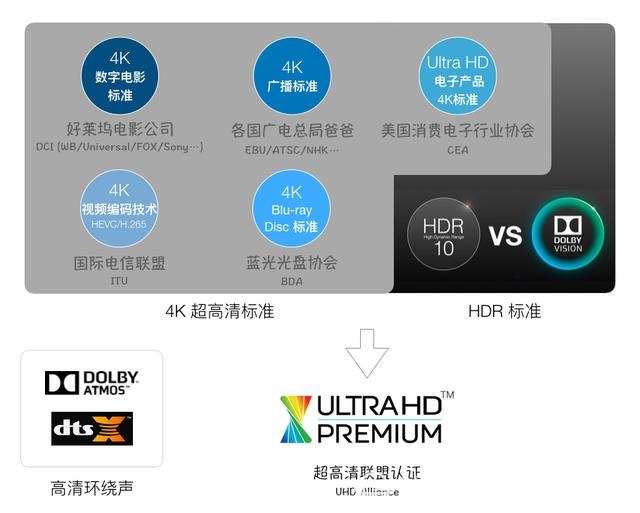
Another thing I experienced after the review was: Many people's YY's "high PC" is not a very easy to build 4K HDR game solution. The PC monitor will be the biggest short board for the PC experience 4K HDR. Want to expand to UHD Blu-ray movie playback at an additional cost. The game console + TV solution has a clear advantage over the PC in terms of price/performance, simplicity, and final results. After all, the latter is produced in accordance with industry standards.
Finally, I will talk about two tips.
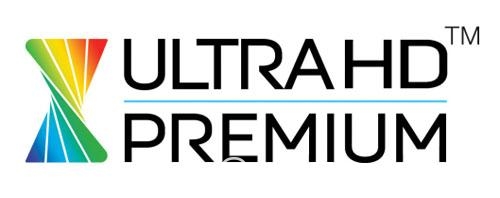
First, everyone can look for Ultra HD Premium certification. Whether it is a TV, a DVD player or a 4K Blu-ray disc, try to pick the product with this logo. This certification was launched by the UHD Alliance with the aim of "fooling" to facilitate consumers. As long as this sign is available, it means that the content or equipment has passed various standards of tests, so that consumers can no longer rack their brains with a bunch of parameters and have no way to judge.

The second is to recommend a very delicate and authoritative 4K HDR TV professional evaluation website: Rtings.com. They are an independent organization and the products tested are self-purchasing, and they are responsible for Amazon's own flow of profits and losses. Their advantage lies in creating a comprehensive evaluation system for 4K HDR TVs. I am interested if I can dig into the details; just to see how a certain model friend, you can also simply look at the score and the final verdict.
In 2017, we ushered in the new concept of ultra-clear games in 4K HDR. Regardless of the number of game players this year's wave can infect their homes, Sony A1E has set an exciting benchmark for us. With such a benchmark, the human visual experience will be constantly refreshed, and video games will benefit from the stimulation of new technologies in all areas before they will evolve more and more exciting.
ZGAR bar 600 Puffs
ZGAR electronic cigarette uses high-tech R&D, food grade disposable pod device and high-quality raw material. All package designs are Original IP. Our designer team is from Hong Kong. We have very high requirements for product quality, flavors taste and packaging design. The E-liquid is imported, materials are food grade, and assembly plant is medical-grade dust-free workshops.
Our products include disposable e-cigarettes, rechargeable e-cigarettes, rechargreable disposable vape pen, and various of flavors of cigarette cartridges. From 600puffs to 5000puffs, ZGAR bar Disposable offer high-tech R&D, E-cigarette improves battery capacity, We offer various of flavors and support customization. And printing designs can be customized. We have our own professional team and competitive quotations for any OEM or ODM works.
We supply OEM rechargeable disposable vape pen,OEM disposable electronic cigarette,ODM disposable vape pen,ODM disposable electronic cigarette,OEM/ODM vape pen e-cigarette,OEM/ODM atomizer device.

Disposable Vape, bar 600puffs, ZGAR bar disposable, Disposable E-cigarette, OEM/ODM disposable vape pen atomizer Device E-cig
ZGAR INTERNATIONAL TRADING CO., LTD. , https://www.zgarecigarette.com